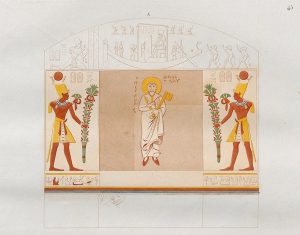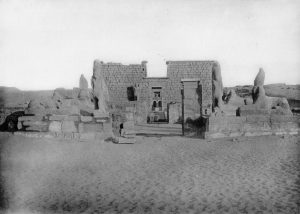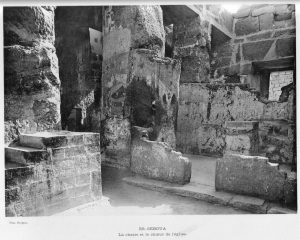As every year, members of Polish missions working in Egypt and Sudan report on their work during a three-day conference (see programme).
In the framework of our project, we investigated the Christian phases of the Temple at Wadi es-Sebua (the Valley of the Lions, c. 150 km south of Aswan). The sanctuary and the hypostyle hall of the Temple of Ramses II were adapted for Christian worship. The image of St. Peter, who is painted at the back of the central sanctuary of the temple, seems to be being adored by Ramesses himself. This image has attracted attention from its discovery in the early 19th century. The church in the hypostyle hall was discovered and documented in 1909 when the temple was excavated in the framework of the First Archaeological Survey of Nubia (1907-1911), following the building of the first Aswan Dam (the Aswan Low Dam).

F.C. Gau, Antiquités de la Nubie ou Monumens inédits des bords du Nil, situés entre la première et deuxième cataracte, Stuttgart 1822
During the 1960s UNESCO campaign to save monuments that would have been flooded after the completion of the Aswan High Dam, the temple was relocated. The church and the baptistery in the hypostyle hall of the temple were demolished in the process and the altar in the central temple sanctuary, in front of St. Peter, was dismantled. The representation of St. Peter was allowed to stay and it is now the only witness of the Christian reuse of the pharaonic monument.
Our contribution centred on the paintings in the church and the baptistery and the reconstruction of the iconographical programme. The architecture and the murals were first documented in 1909 and for the second time in 1964 prior to the relocation of the temple. At that time, the murals were taken from the walls and they are now stored in the Coptic Museum in Cairo where we hope to study them during our coming research visit in November.

H. Gauthier, L’Église nubienne d’es-Sebouâ, dans G. Maspero (éd.), Les temples immergés de la Nubie, Rapports relatifs à la consolidation des temples, Le Caire : IFAO, 1910, pl. CXXII.

H. Gauthier, pl. CXXVIII.
